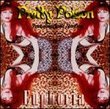| All Artists: Jeno Jando Title: Scarlatti: Complete Keyboard Sonatas, Vol. 3 Members Wishing: 0 Total Copies: 0 Label: Naxos Release Date: 7/17/2001 Genre: Classical Styles: Chamber Music, Forms & Genres, Sonatas, Historical Periods, Baroque (c.1600-1750), Classical (c.1770-1830) Number of Discs: 1 SwapaCD Credits: 1 UPC: 747313504725 |
Search - Jeno Jando :: Scarlatti: Complete Keyboard Sonatas, Vol. 3
 | Jeno Jando Scarlatti: Complete Keyboard Sonatas, Vol. 3 Genre: Classical
|
Larger Image |
CD DetailsSimilar CDs
Similarly Requested CDs
|
CD ReviewsAn incredible variety of mood, colour and rhythm. John Austin | Kangaroo Ground, Australia | 07/28/2001 (4 out of 5 stars) "Almost every keyboard player, whether harpsichordist or pianist, has included sonatas by Domenico Scarlatti (1685-1757) in recitals and recordings. The so-called sonatas number nearly 600. They contain an incredible variety of mood, colour and rhythm, but never a surprise ending - Scarlatti allows you to see an ending coming a mile off. The ubiquitous Jeno Jando is the pianist in this third volume of a projected complete recording of the Scarlatti sonatas undertaken by Naxos Records. Apparently the policy in this project is to use the piano throughout, to observe repeats in each sonata, and to ignore the convention of pairing many of the sonatas. Jando's fingers trip nimbly through a selection of 16 sonatas on this CD. The selection includes ones that are much duplicated in my record collection and some that I have never heard before. Amongst the latter is a virtuoso piece featuring rapid descending scales (Track 2) and another featuring passages of repeated single notes, suggesting guitar technique (Track 3). Offering 67 minutes at extreme budget price, this is very good value indeed. Don't expect top quality piano recording, however. The sound here is strangely muted." Fluidity, speed and emphasis Nancy Moran | Baltimore, Maryland USA | 10/27/2002 (4 out of 5 stars) "It has been a privilege to hear Scarlatti vol. 1 with Eteri Andjapararidze, vol. 2 with Michael Lewin and vol. 3 (this album) with Jeno Jando on the piano. Although it would have been better to hear these works on their written instrument, the harpsichord, I have had a fascinating afternoon.With regard to Jeno Jando, his interpretation of Scarlatti is characterized by its fluidity, speed and emphasis. He abandons the staccato style of Lewin and he does not bring in 20th century interpretations of 17th century material as in vol. 1.This is yet a 20th century creation but it brings to the Baroque a new style which is not to be ignored. Jando does not bring out bouncing rhythms - he uses his left hand in conjunction with the right to bring out emphasis.On the whole, this is a superior album but for true Scarlatti fans, it is important to have ALL the albums in this series." Thoughts about virtuosity Albert E. Everett | Little Rock, AR United States | 11/20/2002 (5 out of 5 stars) "Speed kills. Why do I get the impression that here Scarlatti's Sonatas offer a window of opportunity for intellectual and technical display? I would suggest a careful reading beginning with page 292 in Kirkpatrick's book, "Domenico Scarlatti", on the subject of Tempo and Rhythm. He writes, "All of us, especially the young, have been quilty of playing Scarlatti too fast". He might have said the same thing to young Glenn Gould about the way he, at times, ripped through Bach so incredibly fast.I perceive Scarlatti as a composer who transcribed for harpsichord what he heard and saw as he walked around town in Baroque Spain: song, dance, and expecially quitar. Today we further transcribe the music for pianoforte which offers us greater possibilities of expression. Other things equal, I'd bet that Scarlatti would use the piano as the instrument of choice.So I take exception to Track 2 with its beautiful scales. A slower tempo would produce a very different musical picture: quitar music of marvelous rhythm and spirit; and a warm feeling about things Spanish.Most of the recent Scarlatti CDs are by pianists living well East of Madrid. They are all unique; uniquely personal, uniquely excellent, and uniquely Slavic. Hopefully Naxos will include Spanish-born pianists in this wonderful series.I appreciate J. Jando's performance, musical opinions, and great contributions to a thirsty audience"
|

 Track Listings (16) - Disc #1
Track Listings (16) - Disc #1









